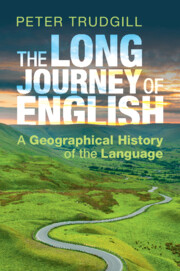Book contents
- The Long Journey of English
- The Long Journey of English
- Copyright page
- Dedication
- Contents
- Figures and Maps
- Acknowledgements
- Prologue: A View from the Birthplace
- 1 Where It All Started: The Language Which Became English
- 2 The Journey Begins: The First Movement South
- 3 Interlude: A View from the Celtic Island
- 4 Heading West Again: The North Sea Crossing, 400–600
- 5 Anglo-Saxons and Celts in the British Highlands, 600–800
- 6 And Further West: Across the Irish Sea, 800–1200
- 7 Atlantic Crossing: On to the Americas, 1600–1800
- 8 Onwards to the Pacific Shore
- 9 Across the Equator: Into the Southern Hemisphere, 1800–1900
- 10 Some Turning Back: English in Retreat
- 11 Meanwhile … Britain and the British Isles from 1600
- 12 Transcultural Diffusion: The New Native Englishes
- Epilogue: Sixteen Hundred Years On
- References
- Index
- References
8 - Onwards to the Pacific Shore
Published online by Cambridge University Press: 25 May 2023
- The Long Journey of English
- The Long Journey of English
- Copyright page
- Dedication
- Contents
- Figures and Maps
- Acknowledgements
- Prologue: A View from the Birthplace
- 1 Where It All Started: The Language Which Became English
- 2 The Journey Begins: The First Movement South
- 3 Interlude: A View from the Celtic Island
- 4 Heading West Again: The North Sea Crossing, 400–600
- 5 Anglo-Saxons and Celts in the British Highlands, 600–800
- 6 And Further West: Across the Irish Sea, 800–1200
- 7 Atlantic Crossing: On to the Americas, 1600–1800
- 8 Onwards to the Pacific Shore
- 9 Across the Equator: Into the Southern Hemisphere, 1800–1900
- 10 Some Turning Back: English in Retreat
- 11 Meanwhile … Britain and the British Isles from 1600
- 12 Transcultural Diffusion: The New Native Englishes
- Epilogue: Sixteen Hundred Years On
- References
- Index
- References
Summary
St John’s, Newfoundland, to Vancouver is about 3,000 miles; Plymouth, Massachusetts, to San Francisco is about 2,700 miles, the distances which English covered on its westward expansion from the Atlantic to the Pacific between 1700 and the late 1800s. Revolution, purchase, negotiation, violent conquest, slavery and genocide brought the continental USA finally to its modern geographical limits. English-speaking powers controlled the east coast of North America from Labrador to Florida, and the west coast from the Arctic Ocean to the USA–Mexico border between San Diego and Tijuana. The 250 years of spread of native English speakers occurred at the expense of indigenous North American languages, and to a lesser extent Spanish, French and the other languages of other European colonists.
Keywords
- Type
- Chapter
- Information
- The Long Journey of EnglishA Geographical History of the Language, pp. 99 - 114Publisher: Cambridge University PressPrint publication year: 2023



